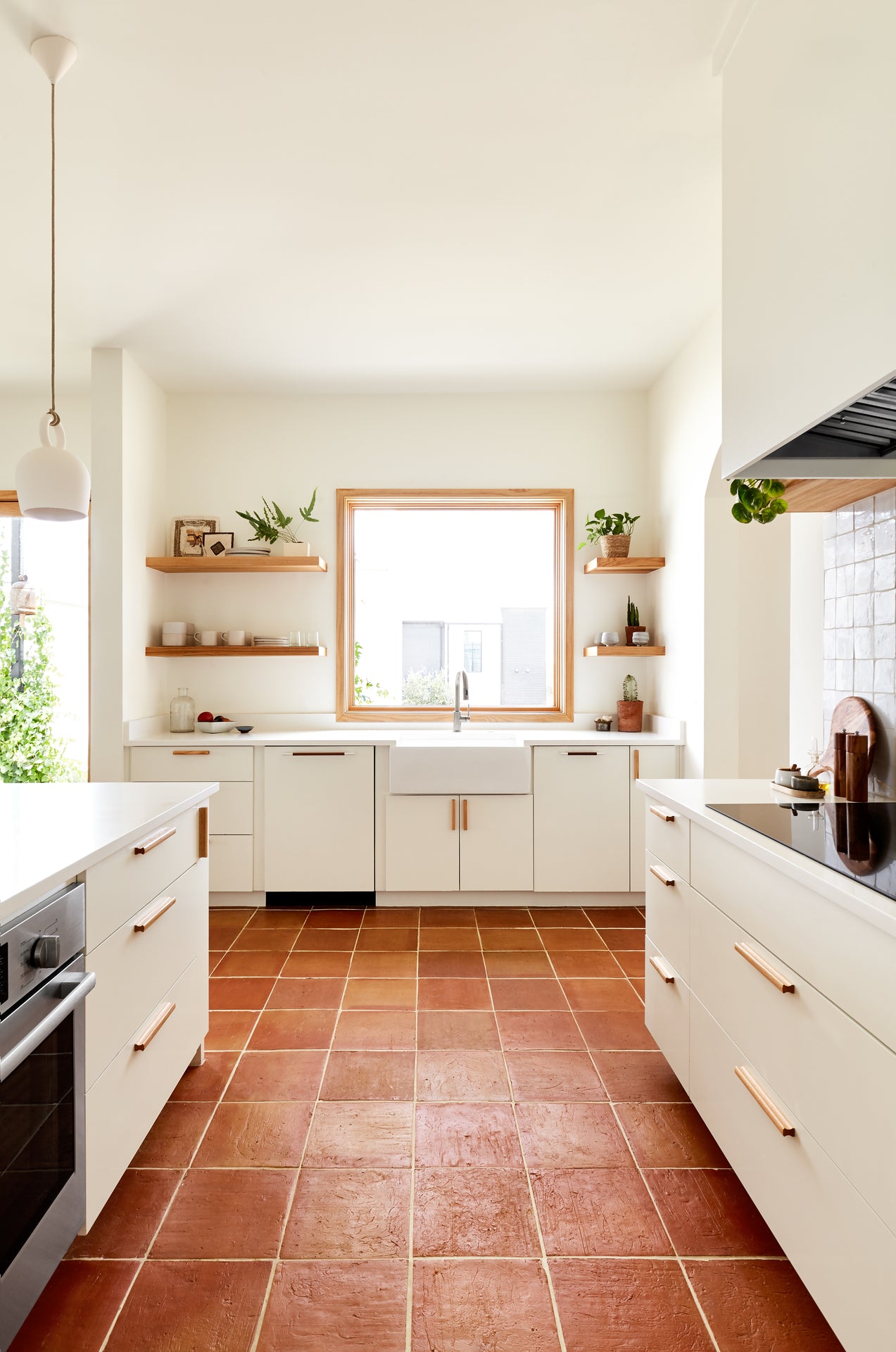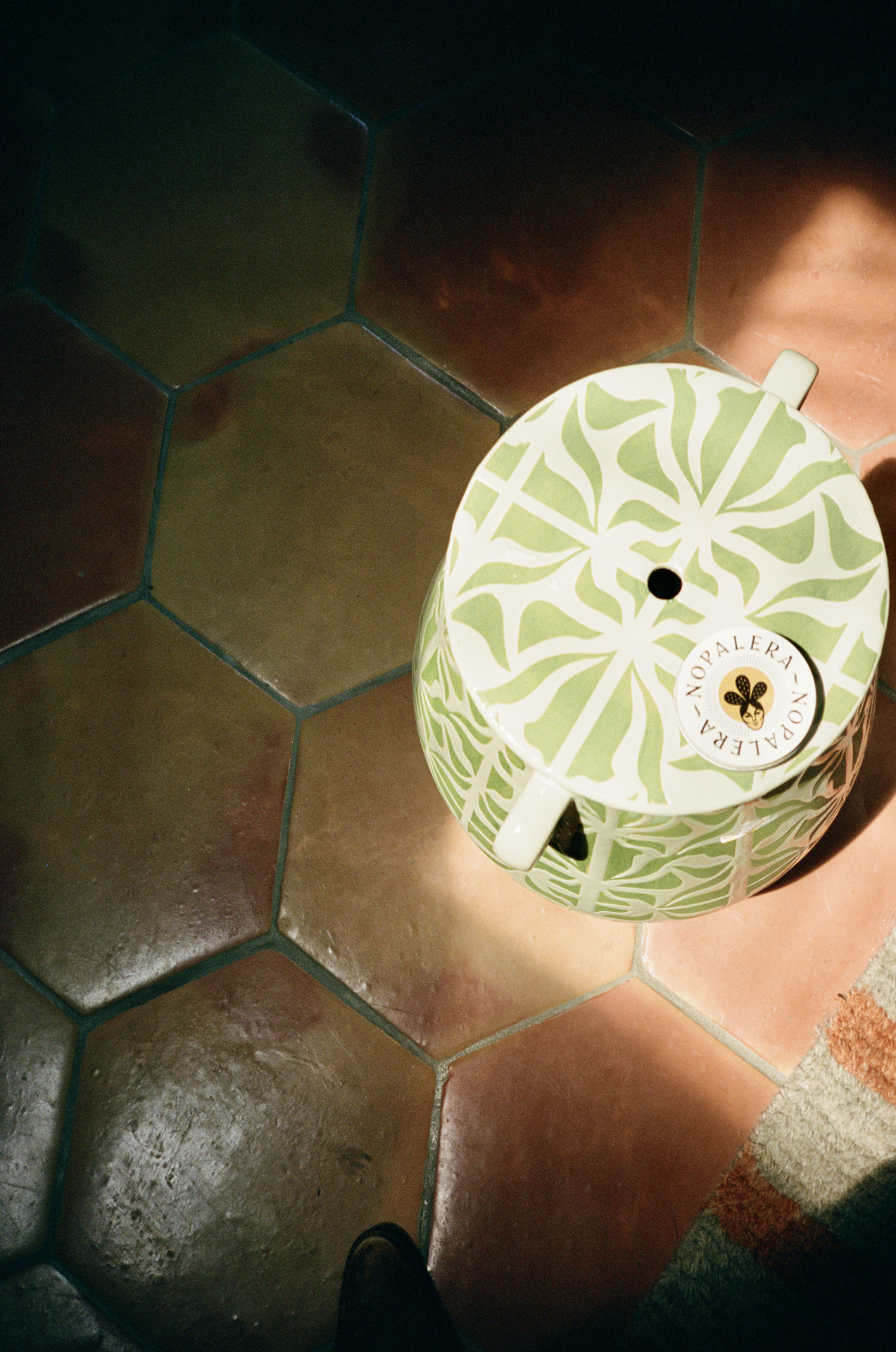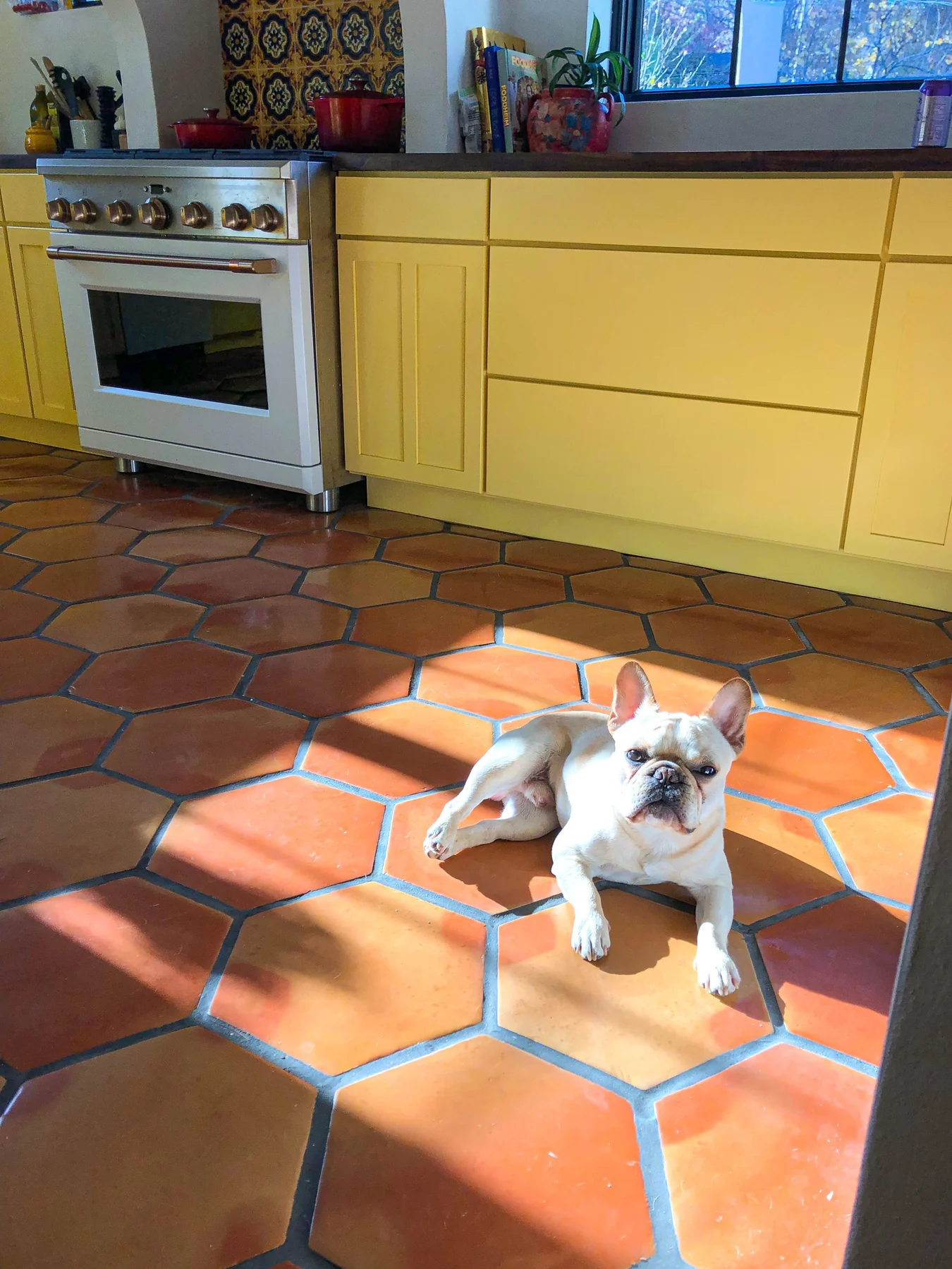6 Unique Characteristics of Authentic Saltillo Tiles
By Clay Imports
Saltillo tiles are among the most popular Mexican tiles globally. These tiles have been used in households all over the U.S., and they are gaining popularity thanks to the tile trends expected in 2024. That’s why customers need to be more careful while shopping for their Saltillo tiles to avoid counterfeits. This article will help you identify the authentic Saltillo tiles and appreciate the craftsmanship of these Mexican tiles.
Cover Photo Design and Installation by Jon Nuckels | Photo by Nick Simonite

What are Saltillo tiles?
Saltillo tiles are made of terracotta, a naturally occurring type of red clay. You’ll often see the terms Saltillo, terracotta, and Mexican tile or stone used interchangeably, but it’s important to note that while all Saltillo tiles are made from terracotta clay, not all terracotta tiles are Saltillo tiles.
Saltillo tiles are produced and manufactured solely in Saltillo, the capital of Coahuila in northwestern Mexico. Just as Champagne can only come from the Champagne region of France, Saltillo tile can only be called Saltillo when it comes from this Mexican region.
The process of making Saltillo tiles involves spreading the terracotta clay in wooden molds and letting it dry. Once dried, the tiles are stacked in wood-burning kilns, where they are fired for 24 hours. This entire process has been perfected by generations and has been kept 100% handmade to ensure the quality of the product. If you want to know more about Saltillo tiles, we have an article that deeply discusses the history and fabrication process of Saltillo tiles.
Saltillo tiles are the environment of what a handmade product should look like and as such they will exhibit natural variations, which are inherent traits of this handmade process. These variations are not defects but rather a natural part of the product. We highly recommend ordering samples before making a final purchase to confirm and appreciate these natural variations in each tile.
 Design Anna Kidd | Photo Yanglin Cai
Design Anna Kidd | Photo Yanglin Cai
Why Saltillo tiles have color stripe and distinct corners?
Saltillo tiles are cherished for their color variations; the amber, gold and peach colors that create a stunning contrast with the terracotta red hues.
Variations in color occur due to the tile's interaction with the surrounding fire within the kiln. When the molded tiles are fired in wood-burning kilns, they are strategically stacked to maximize the number of tiles that can be accommodated. This stacking arrangement exposes different sides or corners of each tile to the heat source. Tiles closer to the fire will develop more yellow-gold tones in those specific areas.
The unique stripes on the square tiles and the distinct corners on the hexagon tiles are a natural outcome of the firing process in the kiln. These characteristics are perfectly normal and actually enhance the authenticity of Saltillo tiles. By blending these different shapes together, you can achieve a visually appealing and cohesive look for your space.
 Design and Install Jon Nuckels | Photo Nick Simonite
Design and Install Jon Nuckels | Photo Nick Simonite


Why Saltillo tiles have size and thickness variations?
The size and thickness variations of Saltillo tiles occur because of the Saltillo climate. The terracotta of the tile is exposed to weather conditions before and after entering the kiln. This exposure affects water that is inside the drying clay, changing the inner structure of the tile. For example, water evaporating unevenly from the clay can be caused by a cloudy day, limiting exposure to the sun; a rainy day means more moisture in the air, leading to longer dry times until the weather clears up, etc.
These factors make the finished tile sizes smaller after the water evaporation process has occurred. The more terracotta your tile has, the more obvious these characteristics will be. With that said, the biggest size we offer for our Saltillo tiles are 16”x16", with our most popular sizes maxing out at 12". Keep in mind, all sizes will have some variation. For example, our 12"x12" molds are measure 12 inches, but once the tiles are finished drying, each tile is approximately half an inch smaller than when it was packed in its mold.
 The variance in size and thickness can make it tricky to grout your Saltillo tile installation. Fortunately, we have you covered with this complete and easy to follow guide on the best options for Saltillo tile grout, with the best tips and tricks to grout your natural Mexican tiles.
The variance in size and thickness can make it tricky to grout your Saltillo tile installation. Fortunately, we have you covered with this complete and easy to follow guide on the best options for Saltillo tile grout, with the best tips and tricks to grout your natural Mexican tiles.
Why Saltillo tiles have lime pops and scratches?
Some bumps on the surface of the tiles, like the ones mentioned before, can trap water inside them, resulting in a lime deposit trapped under the surface. These bumps are natural deposits of minerals left behind once the water has completely evaporated. These lime deposits are not always apparent and can “pop” well after installation, leaving a small white impression in the tile. While exposed lime bumps might catch your eye, there's no need to worry—they're completely normal.
These lime pops can vary in size and may become visible after installation, but again, that's all part of the unique charm of Saltillo tile.
Lime pops, depending on size, may blend in as standard chips over time, or you can always replace the tile or clean the white residue from it. If you prefer to fill in the spots, there are Saltillo repair kits available online that come in terracotta or yellow/orange tones specifically designed for this purpose. Many of our customers have successfully used these kits on their tiles; in fact, Clay Imports has utilized this method in our previous showroom. These kits are also effective for addressing larger spots, check out this video on How to Fill in Saltillo Chips or Lime Pops.

Terracotta is prone to scratching, whether it's surface or deep scratches. Surface scratches can occur from daily use, but they can be easily fixed or accepted as part of the natural aging process. This particular scratch is only on the surface sealer, usually not a long-term issue, but simply cosmetic. Here is a video on How to Repair Saltillo Surface Scratches
Of course, using rugs and being cautious with heavy items can help prevent scratches. Terracotta has been used for hundreds of years, and with regular use, surface scratches are normal for this handmade natural product. This is a common occurrence and can easily be managed, as they are quite livable!
In order to keep your tiles in the best shape possible, we recommend taking a look at our Clay Care products; these maintenance items have been carefully tested with our products, and they are designed to preserve your tiles' beauty, ensuring their longevity and durability. From sealers to cleaners, purchasing these maintenance items together with your tiles not only simplifies your order but also prepares you to enjoy your tiles for a long time.

Why are Saltillo tiles bumpy or pillowed?
Saltillo tiles are hand-smoothed; the maestros ladrilleros will treat each tile with their own hands and use little to no tools to fit the clay inside the molds. This results in an irregular surface and, as mentioned above, affects the way water evaporates to create the solid terracotta tile. This gives you bumps on the surface where the clay was hand-smoothed. This is called pillowing: tiles with concave surfaces that look like they were inflated like a pillow.
This effect will give you another layer of texture to your tile and should be considered when installing. You can always schedule with one of our recommended installers or you can follow our Saltillo installation DIY guide.

Design NJW Real Estate Adventures
Why Saltillo tiles have chips or minor cracks?
By now, you should know that Saltillo tiles are handmade, so they don’t have the characteristics of automated, mass-fabricated tiles. This is an alluring decision for some folks when looking for their materials: something that pays homage to the classic fabrication process and a piece that celebrates the craft behind its creation. The rustic nature of Saltillo tiles makes them uneven and may even show some chips or minor cracks in the corners, sides, and edges. It is important to order an appropriate percentage of overage with each order. Take a look at our FAQ article regarding how to order overage with your tile orders.

Why Saltillo tiles have irregular markings?
Once again, Saltillo tiles are very prone to changes and modifications while exposed to open weather. But one of the most unexpected factors Saltillo tiles endure during drying is the presence of stray animals. Dogs, cats, and even chickens can enter the drying field at any time—and if you've ever tried to catch a cat's attention, you know how challenging it can be! Tiles scratched by animals are highly valued by experts and aficionados, adding a distinctive touch to your next installation.
Why should I use Saltillo tiles?
Saltillo tiles are highly appreciated by homeowners, designers, and contractors for their durable and beautiful construction material. These tiles are the perfect choice for many design aesthetics, and when maintained correctly, they will last for many years to come.
The unique handmade nature of your Saltillo tile can sometimes lead to these distinctive features, but what you may notice as imperfections are actually entirely normal and a sign of authentic, handmade Saltillo tiles.
At Clay Imports, we are experts on Saltillo tiles and we offer a lot of customizable options for your Saltillo tiles: we offer different sealant and texture options, and we are not only the first Saltillo tiles manufacturer that glazed terracotta tiles, we also are the only manufacturer that offers water resistant Saltillo tiles. We are here to help and we can wait to see what you will create with our products. And remember, if you have any questions or require more information, don't hesitate to reach out to us at contact@clayimports.com






 Share
Share
 Pin it
Pin it








